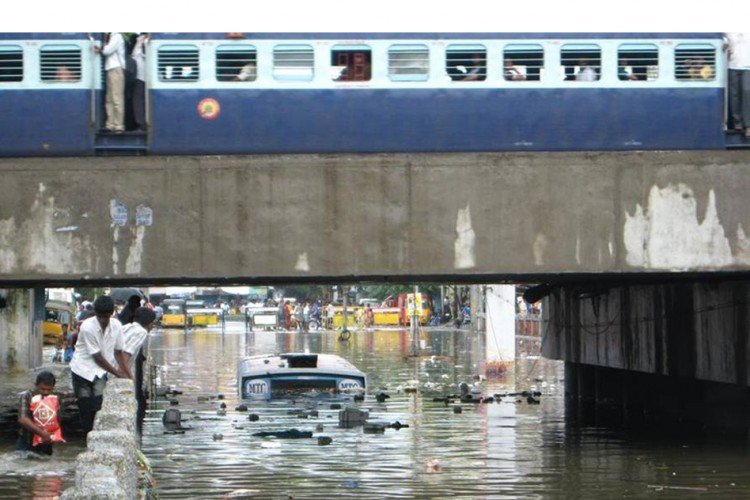If the runway of a city’s airport is built over a dry river, there is that once-in-a-lifetime possibility of the river running over its banks and flooding the airport. On Tuesday, December 1, that’s exactly what happened when the otherwise dry and stagnant Adayar river that runs under the secondary runway of the international airport overflowed its banks and water spilled all over the tarmac and aprons. This was in addition to the torrential rainfall that submerged one of India’s biggest cities and left many thousands stranded.
The airport was declared closed, first for three days and later extended for five days. As this is written, the airport has been declared shut till December 6. This is unprecedented in the history of the busy airport, a hub for southern India, which has been declared closed during heavy showers but never flooded and been inoperable for so many days at a stretch.
Train traffic was similarly disrupted and major roads caved in as the heavy rains inundated the teeming urban centre of more than four million people and low lying areas went under water. The armed forces had to be called in for rescue and relief. The Indian Navy sent in INS Airavat to join in the operations. Essentials such as drinking water, food and medicines were in short supply.
Scores of people were reported killed in the unprecedented heavy rainfall that lashed the coastal capital of Tamil Nadu in November and ran into December. The end result was that during the northeast monsoon of 2015, starting from October 1, Chennai received rainfall of 1,506.9 mm, which is in excess of the city’s annual average rainfall of 1,468 mm. In November 2015, the precipitation was 1,197.3 mm, which was more than the earliest highest in the century level of 1,088 mm recorded in 1918.
In the 24 hours between December 1 and 2, the city reportedly recorded 294 mm and 345 mm in two observatories, the highest rainfall since 1901.
The deluge that followed was literally Chennai Floods Version 2.0 — the city had taken a sunny respite of just a few days and was coming back to life after the heavy rains of mid-November. Version 2.0 had an additional complication. The floods were being caused not only by the rainwater falling on the city, but also due the administration being forced to release water that was overflowing the city’s storage reservoirs.
Thus, when the Chembarambakkam reservoir had to be eased to release excess water, it flowed through its natural drainage into the sea – the Adayar river. It flowed into the Chennai airport. The walled premises of the airport became a temporary open reservoir for the water.
Aircrafts destined for Chennai could not land, and those at the airport could not leave. In the touch down and take off world of commercial aviation, having a few aircrafts locked up at the Chennai airport meant disturbance of schedules all over the country. And since the outside of the airport terminal was one of the areas badly inundated, those inside the buildings could not reach their homes in different parts of the city and outside.
What caused these unusually copious rains in Chennai during this northeast monsoon season?
“Even as the world discusses climate change in Paris, Chennai is perhaps experiencing its impact – the unprecedented deluge that the city has been subjected to is a reminder of increasing frequency of such freak weather events across the Indian sub-continent,” the Centre for Science and Environment (CSE) said in a press note.
“We have repeatedly drawn attention to the fact that our urban sprawls such as Delhi, Kolkata, Mumbai, Chennai, Srinagar etc have not paid adequate attention to the natural water bodies that exist in them. In Chennai, each of its lakes has a natural flood discharge channel which drains the spillover. But we have built over many of these water bodies, blocking the smooth flow of water. We have forgotten the art of drainage. We only see land for buildings, not for water,” CSE director general Sunita Narain said.
According to Skymetweather.com, these rains were caused due to a combination of the El-Nino and the positive Indian Ocean Dipole phenomena.
“El-Nino is an oceanic-atmospheric phenomenon where sea surface temperatures of East Pacific Ocean warm up, while the Indian Ocean and the Bay of Bengal have relatively cool temperatures,” noted Skymetweather, which has become a quick go to site for nuanced weather information. “For the development of any cyclone or strong weather system, we require warm sea surface temperatures (SST). As a result, central Bay of Bengal did not witness any weather systems this year on account of cooler SST.”
However, the positive Indian Ocean Dipole added a different dimension. The Indian Ocean Dipole system is a periodic oscillation of SST within the Indian Ocean. During a positive Indian Ocean Dipole year there is a greater than average warmth over the sea surface resulting in the western part of the ocean leading to the development of low-pressure areas. This resulted in the development of three strong weather systems developing in South Andaman Sea this season resulting in back-to-back rains in Chennai and other parts of coastal Tamil Nadu and Andhra Pradesh.
Prone to flooding
Chennai city is prone to flooding. It is a topographically flat city, with altitude ranging from 2 m to 15 m above sea level. Four rivers run from west to east into the sea cutting through the city. Of this, two rivers – Cooum and Adayar – are within the main city area. Since the city is otherwise water-deficient, these rivers are blocked with bunds upstream of the city and their flow stored in four reservoirs.
According to CSE, Chennai had more than 600 waterbodies in the 1980s, but a master plan published in 2008 revealed that only a “fraction of the lakes could be found in a healthy condition. According to records of the state’s Water Resources Department, the area of 19 major lakes has shrunk from a total of 1,130 hectares (ha) in the 1980s to around 645 ha in the early 2000s, reducing their storage capacity. The drains that carry surplus water from tanks to other wetlands have also been encroached upon”.
Chennai Flood 2.0 was more severe than the previous one because water was being released from the reservoirs that otherwise are used to store water. This led to flooding of all the areas which were either in the path of the rivers that originated from reservoirs, or were in the lower parts of the city. Thus, settlement along the banks of the Adayar and Cooum rivers, and those in the vicinity of swamps and lakes got high flooding.
Somewhere in its growth, the residents of the city forgot the natural contours of their habitat, built along and across rivers, filled up lakes and ponds and massively encroached upon the Pallikarnai Swamp. Resultantly, the once in a century event became a huge nightmare.
For the rain-weary Chennai and adjoining areas, three nearly back-to-back events have caused much suffering and anguish, and the hope is that the weather will blend into a pleasant winter sooner than later.
The ability of the city to deal with events such as this is decreasing. Indirectly proportional to this ability is the city’s vulnerability to climate change-related extreme weather events, as and when they happen.
Gopikrishna Warrier is regional environment manager with Panos South Asia.
See also: Last year’s Chennai deluge not due to climate change

